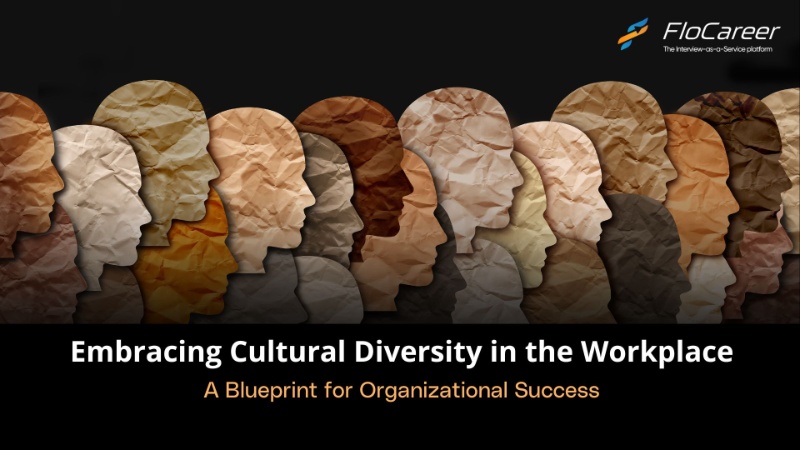Embracing Cultural Diversity in the Workplace: A Blueprint for Organizational Success
In the rapidly evolving landscape of today's economy, adaptability stands as a crucial skill. Both individuals and organizations must navigate the shifting sands of workplace dynamics, with a key focus on diversity and inclusion. As demographics transform, fostering cultural diversity in the workplace becomes not just a goal but a necessity. This blog explores the facets of cultural diversity, its significance, types, and the multitude of benefits it brings to the modern workplace. Additionally, we'll delve into how Interview as a Service (IaaS), exemplified by FloCareer, aligns with and enhances the ethos of a culturally diverse workforce.

What is Cultural Diversity?
Cultural diversity encompasses the myriad expressions of customs, practices, beliefs, and worldviews within a population. It transcends geographical boundaries, forming the rich tapestry of human cultural traits and behaviors distributed through time and space.
Why is Cultural Diversity Important?
Cultural diversity is a catalyst for better communication, heightened teamwork, and enhanced creativity in the workplace. The amalgamation of diverse perspectives fuels innovation, leading to unique solutions that flourish in an environment where assumptions are not uniform.
Types of Workplace Diversity:
Gender: Fostering an inclusive workplace that values diverse perspectives and approaches to work, breaking gender stereotypes, and ensuring equal opportunities for all employees.
Education: A mix of educational backgrounds introduces a wealth of knowledge, skills, and approaches, promoting a collaborative environment where learning is continuous.
Religion: Emphasizing the importance of respecting and accommodating diverse religious beliefs, creating an environment where individuals can practice their faith without discrimination.
LGBTQ+: Establishing an open and inclusive space where LGBTQ+ employees feel safe to express their identities, fostering a sense of belonging and equality.
Race and Ethnicity: Encouraging improved communication skills by bringing together individuals from different countries and backgrounds, fostering a workplace that celebrates cultural diversity.
Age: Addressing prejudices related to age, promoting understanding, collaboration, and knowledge-sharing between different age groups for a harmonious work environment.
Disabled Workers: Enhancing workplace accessibility and inclusivity for employees with disabilities, recognizing and valuing the unique insights and contributions they bring to the organization.
Mental Health: Prioritizing a supportive and understanding workplace that promotes employee well-being, leading to improved performance and a positive company culture.
Benefits of Cultural Diversity in the Workplace:
1. Develop and Maximize Skill Sets:
Cultivating a diverse workforce leads to a rich pool of skills and experiences, creating a dynamic environment where employees continually learn from each other.
2. Improves Recruitment Process:
Diverse perspectives in the recruitment process ensure a broader view of potential candidates, contributing to fairer hiring decisions and the discovery of hidden talent.
3. Helps Retain Talent:
A diverse and respectful workplace fosters a sense of belonging and value, contributing significantly to employee satisfaction and long-term commitment.
4. Improves Team Creativity:
Cultural diversity fuels creativity by incorporating a variety of perspectives and ideas, fostering an environment where innovation thrives.
5. Increase Employee Engagement:
Cultural diversity enhances employee engagement as individuals feel a connection to the company's mission and values, contributing actively to its success.
6. Company’s Reputation Improves:
Businesses with diverse workforces are viewed positively by the public, improving their reputation and attractiveness to top-tier talent.
7. Productivity Increases:
Culturally diverse teams leverage a variety of skills and perspectives, resulting in increased productivity through effective problem-solving and collaboration.
Ensuring Cultural Diversity in the Workplace: A Comprehensive Approach
Implement Inclusive Policies:
Develop and enforce policies that promote inclusivity, nondiscrimination, and equal opportunities for all employees, irrespective of their cultural background.
Diversity Training Programs:
Conduct regular diversity training programs to raise awareness about cultural differences, biases, and the importance of fostering an inclusive work environment.
Create Affinity Groups:
Establish affinity groups or employee resource groups that celebrate various cultures and provide a platform for employees to share their experiences and insights.
Flexible Work Arrangements:
Offer flexible work arrangements that accommodate different cultural practices, holidays, and religious observances, allowing employees to balance work and personal life.
Cultural Sensitivity Workshops:
Organize workshops on cultural sensitivity to educate employees about diverse traditions, customs, and communication styles, fostering understanding and respect.
Diverse Leadership Representation:
Strive for diverse representation at leadership levels, ensuring that decision-makers reflect the varied backgrounds and perspectives within the workforce.
Open Communication Channels:
Encourage open communication channels where employees feel comfortable discussing cultural differences, raising concerns, and providing feedback without fear of judgment.
Recognition and Celebration:
Acknowledge and celebrate cultural events, festivals, and heritage months, demonstrating the organization's commitment to diversity and fostering a sense of unity.
Evaluate Hiring Practices:
Regularly assess and update hiring practices to eliminate biases, ensuring that recruitment processes attract a diverse pool of candidates.
Mentorship and Sponsorship Programs:
Implement mentorship and sponsorship programs that connect employees from different backgrounds, providing support and guidance for career development.
Performance Reviews:
Ensure that performance reviews are conducted objectively, with a focus on skills, accomplishments, and contributions rather than cultural background.
Accessible Resources:
Provide accessible resources and support networks for employees with diverse needs, including language resources, mental health support, and accommodations for disabilities.
Regular Diversity Audits:
Conduct regular diversity audits to assess the effectiveness of diversity initiatives, identify areas for improvement, and track progress over time.
Collaborative Decision-Making:
Foster a collaborative decision-making culture where diverse perspectives are actively sought and valued in shaping the direction of the organization.
Continuous Improvement:
Embrace a mindset of continuous improvement, recognizing that cultural diversity is an ongoing journey that requires regular assessment, adaptation, and commitment from all levels of the organization.
The Role of Interview as a Service (IaaS): Transforming Tech Recruitment
In the context of cultural diversity, Interview as a Service (IaaS) plays a pivotal role by offering unbiased and standardized interview processes. By eliminating unconscious biases, IaaS ensures fair assessments, promoting diversity and inclusivity in tech hiring. Platforms like FloCareer provide a level playing field for candidates, regardless of their background, contributing to the creation of a diverse and vibrant workforce.
Cultural diversity in the workplace is not merely a checkbox; it's a strategic imperative for organizations aspiring to thrive in the contemporary business landscape. As we celebrate the benefits of diversity, integrating Interview as a Service amplifies the journey towards a workplace that not only embraces differences but also harnesses them for unparalleled success. In the mosaic of modern workplaces, cultural diversity isn't just a choice; it's the key to unlocking innovation, creativity, and sustained excellence.
Check out our latest blog on Leadership Development


